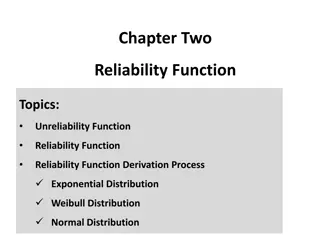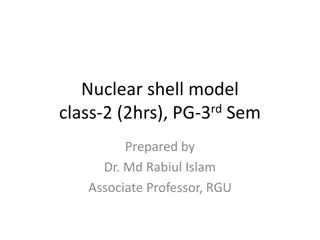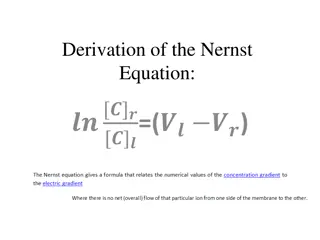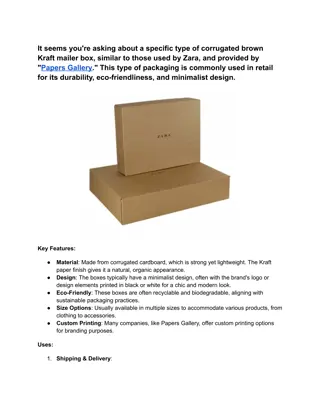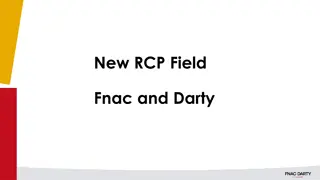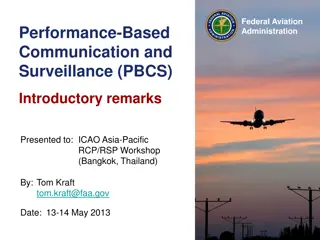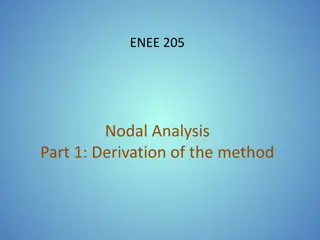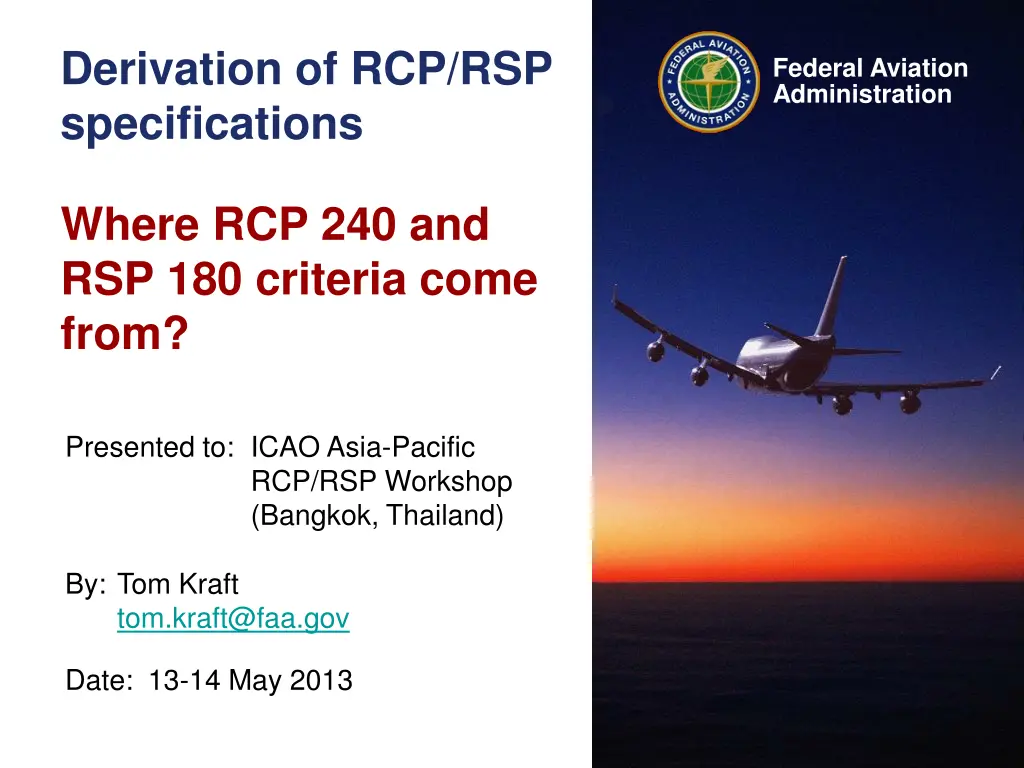
Understanding Derivation of RCP/RSP Specifications in Aviation
Explore the origins of RCP 240 and RSP 180 criteria in the Federal Aviation Administration's specifications, derived from separation standards and safety assessments, to ensure efficient communication and conflict resolution in air traffic management.
Download Presentation

Please find below an Image/Link to download the presentation.
The content on the website is provided AS IS for your information and personal use only. It may not be sold, licensed, or shared on other websites without obtaining consent from the author. If you encounter any issues during the download, it is possible that the publisher has removed the file from their server.
You are allowed to download the files provided on this website for personal or commercial use, subject to the condition that they are used lawfully. All files are the property of their respective owners.
The content on the website is provided AS IS for your information and personal use only. It may not be sold, licensed, or shared on other websites without obtaining consent from the author.
E N D
Presentation Transcript
Derivation of RCP/RSP specifications Federal Aviation Administration Where RCP 240 and RSP 180 criteria come from? Presented to: ICAO Asia-Pacific RCP/RSP Workshop (Bangkok, Thailand) By: Tom Kraft tom.kraft@faa.gov Date: 13-14 May 2013
RNP C N Introduction ATM S RCP RSP The application of 30 NM and 50 NM longitudinal separation minima are predicated on C, N and S performance PBCS provides global RCP/RSP specifications for C and S performance supporting this ATM function (GOLD / Doc 9869) RCP 240 and RSP 180 time criteria were derived from the separation standards for applying these separation minima (contained in Doc 4444) This was the most stringent scenario Continuity, availability and integrity criteria were derived from an operational safety assessment (RTCA DO-264/EUROCAE ED-78A) Derive RCP RSP criteria 13-14 May 2013 Federal Aviation Administration 2
RCP 240 RSP 180 time requirements Collision risk modeling (CRM) assumes times for normal means of C and S Doc 4444 30 and 50 NM longitudinal separation 5.4.2.6.4.3.2 enable the application of the separation minima in 5.4.2.6.4.3 shall allow a controller, within 4 minutes, to intervene and resolve a potential conflict by contacting an aircraft using the normal means of communication. The communication system provided to 5.4.2.6.4.3.3 event report is not received within 3 minutes of the time it should have been sent, the report is considered overdue and the controller shall take action to obtain the report as quickly as possible, normally by ADS-C or CPDLC. When an ADS-C periodic or waypoint change Derive RCP RSP criteria 13-14 May 2013 Federal Aviation Administration 3
Side note RCP 400 RSP 400 CRM assumes times for alternative means of C and S based on traditional systems (e.g. HF voice via radio operator); these time criteria can be applied to non-traditional systems (e.g. SATVOICE) Doc 4444 30 and 50 NM longitudinal separation 5.4.2.6.4.3.2 An alternative means shall be available to allow the controller to intervene and resolve the conflict within a total time of 10 minutes, should the normal means of communication fail. 5.4.2.6.4.3.3 If a report is not received within 6 minutes of the time the original report should have been sent, and there is a possibility of loss of separation with other aircraft, the controller shall take action to resolve any potential conflict(s) as soon as possible. The communication means provided shall be such that the conflict is resolved within a further 7 minutes. Informal survey of participating ANSPs on when a response is late and when a position report is overdue Derive RCP RSP criteria 13-14 May 2013 Federal Aviation Administration 4
Relationship of RCP/RSP to tau () CRM uses a communication and controller intervention buffer referred to as tau ( ) (per Doc 9689, Appendix 5) RTCA DO-306/EUROCAE ED-122 provides results of analysis to allocate RCP/RSP time criteria from tau ( ) to communication and surveillance components Tau ( ) for 30 / 50 NM longitudinal separation = 4 minutes (240 seconds); 3 minutes (180 seconds) is derived from Tau ( ) Derive RCP RSP criteria 13-14 May 2013 Federal Aviation Administration 5
Table 5-5 from RTCA DO-306 / EUROCAE ED-122 Scenario Normal communication Non-normal communication Non-normal surveillance Value of communication and controller intervention buffer, 240 seconds (4 minutes) 630 seconds (10 minutes) 810 seconds (13 minutes) Element related to the PR service Position report delivery time < 90 seconds Note: Not included in value of . < 90 seconds Note: Not included in value of . 180 seconds Note: Time after which the controller expected the ADS-C report to have been sent, and was not received. Time for the controller to recognize the potential conflict and to devise an alternative means of separation 30 seconds 30 seconds Not applicable. Missing report. Element related to the CRD service Time taken to communicate the instructions to the pilot Normal means of communication, DCPC (CPDLC) 105 seconds. Note: Controller message composition - 15 seconds; uplink 90 seconds. Normal operations assumes normal means of communication, DCPC (CPDLC) is functioning. Time for the controller to receive and recognize the response to the instruction is not included. 195 seconds Note: Time after which the controller initiates communication, via normal means, and receives no response. By then, the controller would have initiated communication via alternative means. 195 seconds Note: Time after which the controller initiates 1st attempt to obtain report, via ADS-C demand contract and/or CPDLC, and receives no response. By then, the controller would have initiated communication via alternative means. Time taken to communicate the instructions to the pilot (via alternative means of communication, assumed to be third party voice) Not applicable 300 seconds. Note: Time after which the controller initiates communication, via alternative means of communication, and receives no response. By then, the controller would have initiated communication with other aircraft. 300 seconds Note: Time after which the controller initiates 2nd attempt to obtain report, via alternative means of communication, and receives no response. By then, the controller would have initiated communication with other aircraft. Time for the pilot to react and initiate an appropriate maneuver 30 seconds 30 seconds 30 seconds Time for the aircraft to achieve a change of trajectory sufficient to 75 seconds 75 seconds 75 seconds Derive RCP RSP criteria 13-14 May 2013 ensure that a collision will be averted Federal Aviation Administration 30 seconds 6 Extra allowance 0 0
RNP C N CNS/ATM context Reduced separation minima Reduced separation minima ATM S RCP RSP RNP Navigation Surveillance Surveillance Communication Communication Surveillance data Surveillance data Operational communication transaction ATM context ATM context RSP RSP RCP Conflict communications and controller intervention buffer ( ) Aircraft is safely displaced detectection Derive RCP RSP criteria 13-14 May 2013 Federal Aviation Administration 7
RCP communication transaction time Interoperability & functional definition RCP specification (communication transaction time) RCP 240 RCP Controller receives indication and confirms response Controller composes and sends message Operational Performance (Monitored) Communication transaction time Part of 30 Part of 30 99.9% 210 ET Part of 30 Part of 30 95% 180 TT RCTP (Ground to Air) PORT RCTP (Air to Ground) P(150) 60 P(150) 99.9% 99.9% P(120) 60 P(120) 95% 95% ATSU system Aircraft system Aircraft system ATSU system CSP CSP Derive RCP RSP criteria 13-14 May 2013 95% Federal Aviation Administration P(10) P(15) P(120) P(15) P(15) P(120) P(15) 99.9% 99.9% 8 P(10) P(100) P(10) P(10) P(100) 95%
RSP surveillance data transit time Interval Interoperability & functional definition X Event RSP specification (surveillance data transit time) RSP 180 RSP Time at position (RNP at +/-1 sec UTC) ATSU receives surveillance data Operational Performance (Monitored) Surveillance data transit time 99.9% 180 OD 95% 90 DT Aircraft system CSP ATSU system 5 170 5 99.9% 99.9% 3 84 3 95% 95% Derive RCP RSP criteria 13-14 May 2013 Federal Aviation Administration 9
RCP continuity There is no requirement to provide an indication to the controller if a communication transaction exceeds the nominal (TT) time value If a communication transaction is not completed within the operational (ET) time value, the system is required to provide an indication to the controller for appropriate action The frequency at which this indication occurs affects controller workload Operational safety assessment classified the effect of a delayed response to an ATC instruction as minor Minor equates to a likelihood of occurrence of no greater than 10-3, or a 99.9% success rate Derive RCP RSP criteria 13-14 May 2013 Federal Aviation Administration 10
RSP continuity There is no requirement to provide an indication to the controller if a surveillance data (position) report exceeds the nominal (DT) time value If a surveillance data report is overdue (i.e., not delivered within the operational (OD) time value), the system is required to either automatically take action and/or provide an indication to the controller for appropriate action The frequency at which this indication occurs affects the latency and accuracy of the surveillance data, which affects conformance monitoring and controller workload Operational safety assessment classified the effect of an overdue surveillance data report as minor Minor equates to a likelihood of occurrence of no greater than 10-3, or a 99.9% success rate Derive RCP RSP criteria 13-14 May 2013 Federal Aviation Administration 11
RCP RSP availability (1 of 3) RCP RSP availability requirement for aircraft Determines number of redundant components; one component can meet 0.999 availability Operators can choose different radios (e.g. Iridium SBD, Inmarsat Classic Aero/SBB, HFDL), but the number of radios required is typically specified by operating rules and airspace requirements for voice communications RCP RSP availability requirement for communication services Assumes that failed data link components within the ANSP would not significantly contribute to loss of the data link service RCP 240 RSP 180 availability requirements Availability parameter Efficiency Safety Compliance means Service availability (ACSP) Unplanned outage duration limit (min) 0.9999 0.999 10 10 Contract/service agreement terms Maximum number of unplanned outages 4 48 Maximum accumulated unplanned outage time (min/yr) 52 520 Unplanned outage notification delay (min) 5 5 Note. DO 306/ED 122 specifies a requirement to indicate loss of the service. Unplanned outage notification delay is an additional time value associated with the requirement to indicate the loss to the ATS provider per the RCP/RSP Derive RCP RSP criteria 13-14 May 2013 related safety requirement (SR) 4 for the ANSP. Federal Aviation Administration 12
RCP RSP availability (2 of 3) If communication or surveillance service is lost, some form of action will be necessary Frequency at which service is lost could affect the application of separation minima being applied when service is lost It may be necessary to apply a different form of separation Operational safety assessment classified the effect of loss of service as minor Minor equates to a likelihood of occurrence of no greater than 10-3, or 99.9% of the time services would be available Derive RCP RSP criteria 13-14 May 2013 Federal Aviation Administration 13
RCP RSP availability (3 of 3) The availability of service requirement is calculated based on 24/7 operation, given a 12 month period of operation 24/7 = 168 hours per week x 52 weeks per year = 8736 hours or 524,160 minutes 99.9% (for safety) available service allows 0.001 down time or 524 minutes/year of a 24/7 operation 99.99% (for efficiency) available service allows 0.01 down time or 52.4 minutes/year of a 24/7 operation. Down time due to planned maintenance is not included Derive RCP RSP criteria 13-14 May 2013 Federal Aviation Administration 14
RCP RSP integrity (1 of 2) The operational RCP RSP integrity requirements are specified in terms of likelihood of malfunction Likelihood of failure per flight hour, instead of quality of service RCP RSP allocations are specified in terms of safety requirements for the components of the operational system Integrity is not allocated like time parameters, since integrity is achieved through system design, architecture and supporting analysis (e.g. cyclic redundancy checks and flight plan correlation with logon, information System integrity issues discovered post-implementation should be reported to the appropriate Regional/State monitoring agency and/or authorities for appropriate action RCP 240 RSP 180 availability requirements Integrity parameter Integrity value Compliance means Malfunction = 10-5 (per flight hour) Analysis, safety requirements, development assurance level commensurate with integrity level, (compliance shown prior to operational implementation). See also RCP related safety requirement SR-26 for the ATSP. CSP contract/service agreement. See also RCP integrity criteria for CSP, paragraph B.2.1.2. Integrity (I) Derive RCP RSP criteria 13-14 May 2013 Federal Aviation Administration 15
RCP RSP integrity (2 of 2) There usually is no operational visibility of communication or surveillance services that do not meet integrity requirements RCP RSP integrity ensures that the effects of malfunction of communication or surveillance services are adequately mitigated in design and implementation The mitigation strategy take the form of safety and performance requirements allocated to system components, which are qualified prior to operation Operational safety assessment classified the effects of undetected message corruption, mis-delivery and other misleading anomalous system behavior as major Major equates to a likelihood of occurrence of no greater than 10-5 probability of malfunction per flight hour For RSP integrity, in addition to addressing undetected corruption of data in delivery, the requirements include criteria for accuracy of navigation position data and time at the position provided in the surveillance data (e.g., RNP 4 at +/- 1 second UTC) Derive RCP RSP criteria 13-14 May 2013 Federal Aviation Administration 16
Conclusion Doc 4444, 5.4.2.6.4.3.2 and 5.4.2.6.4.3.3, provide C and S time criteria for applying 30 NM and 50 NM longitudinal separation minima (CRM) Continuity, availability and integrity criteria are derived from an operational safety assessment (per DO-264/ED-78A) Based on RCP and RSP specifications, PBCS enables ANSPs to ensure C and S system performance meets these time criteria to safety apply these separation minima Derive RCP RSP criteria 13-14 May 2013 Federal Aviation Administration 17
Derive RCP RSP criteria 13-14 May 2013 Federal Aviation Administration 18





